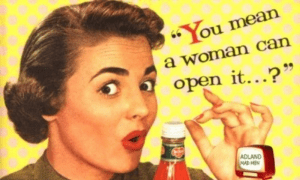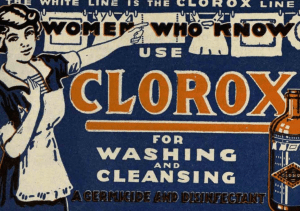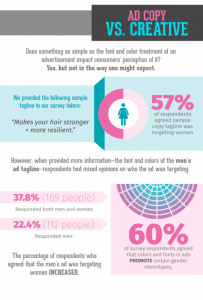Gender Stereotypes have been banned from British Advertising by the Advertising Standards Authority. Advertisements which are likely to cause harm, serious or widespread offense.
This is a topic which I raised at our termly Digital Marketing Convention, a topic which caused a lot of discussion, so I was keen to publish it here.
Gender Stereotypes in Marketing
The report (Vox, 2019) discusses it as marketing which stereotypes people, promotes unhealthy thin models and results from a “general public of unease about the harmful effects of advertising particularly on children”
Images such as these:

Source (Vox, 2019)
These images portray that a man cannot change a babies nappy and women are expected to do domestic duties. As we live in a world of equality where these tasks are equal. Some good discussion points which I had with the students were “Do we really live in a world of equality?” “Are we trying to portray an idealistic image of what we’d like in the world?” “Is it the advertising agency’s responsibly to portray equality?”
And it was only 40-50 years ago since we were seeing adverts like this:

Due to this new standard, this Philadelphia advert was one of the first to get banned. Complainants said the tongue-in-cheek ad perpetuated a harmful stereotype suggesting men were incapable of caring for children and would put them at risk as a result of their incompetence. The ASA banned the ad, saying it reinforced the idea that men were ineffective childcarers. (The Guardian, 2019)
Another advert to get banned under this new standard is this VW advert. Complainants said the ad showed men engaged in adventurous activities, that unlike her male counterpart, the female rock climber was “passive” because she was asleep, and that the woman with the pram was depicted in a stereotypical care-giving role. The ASA, “concluded that the ad presented gender stereotypes in a way that was likely to cause harm”. (The Guardian, 2019)
Under the new rules adverts cannot show:
- Men or women “failing to achieve a task specifically because of their gender” (“e.g. a man’s inability to change nappies; a woman’s inability to park a car”)
- Stereotypical personality traits” for boys and girls,
- Suggest that new mothers “should prioritise their looks or home cleanliness over their emotional health.”

It does not ban:
- It does not ban showing women or men performing stereotypical tasks (e.g., women shopping or men doing at-home construction projects)
- Also ads can still be targeted based on gender
- Ads can still use “gender stereotypes as a means to challenge their negative effects.” (Vox, 2019)
When does Gender become Stereotyped?
I thought this viral video from Always was an excellent way to answer this question and a child’s perception and changed in teenage years based on other people’s influence and advertising.
1. Roles: Occupations or positions usually associated with a specific gender
2. Characteristics: Attributes or behaviours associated with a specific gender
3. Mocking people for not conforming to stereotype: Making fun of someone for behaving or looking in a non-stereotypical way
4. Sexualisation: Portraying individuals in a highly sexualised manner.
5. Objectification: Depicting someone in a way that focuses on their body or body parts
6. Body image: Depicting an unhealthy body image
When will New Zealand be affected?
· Belgium, France, Finland have recently implemented a similar law.
· Norway has had this regulation since 1978.
· But the US regulation only relates to advertising for targeting children.
· UK traditionally has a much tough regulations and enforcement
· It is unlikely NZ TV will be affected anytime soon.
Does Gender have a place in Digital Advertising?
Choozle recently did a study surveying 500 men and women on the topic of Gender Stereotyping in Digital Advertising and got some interesting results:
(Choozle, 2017)
Additional reading & sources
Gender stereotyping ads banned by ASA and “zero-click” searches surge
The Geena Davis Institute – Gender Bias in Advertising Research, Trends and New Visual Language
Gender Stereotyping in Digital Advertising Survey
Does gender have a place in digital advertising?
Gender stereotypes have been banned from British ads. What does that mean?
Author: Emily Cordwell





